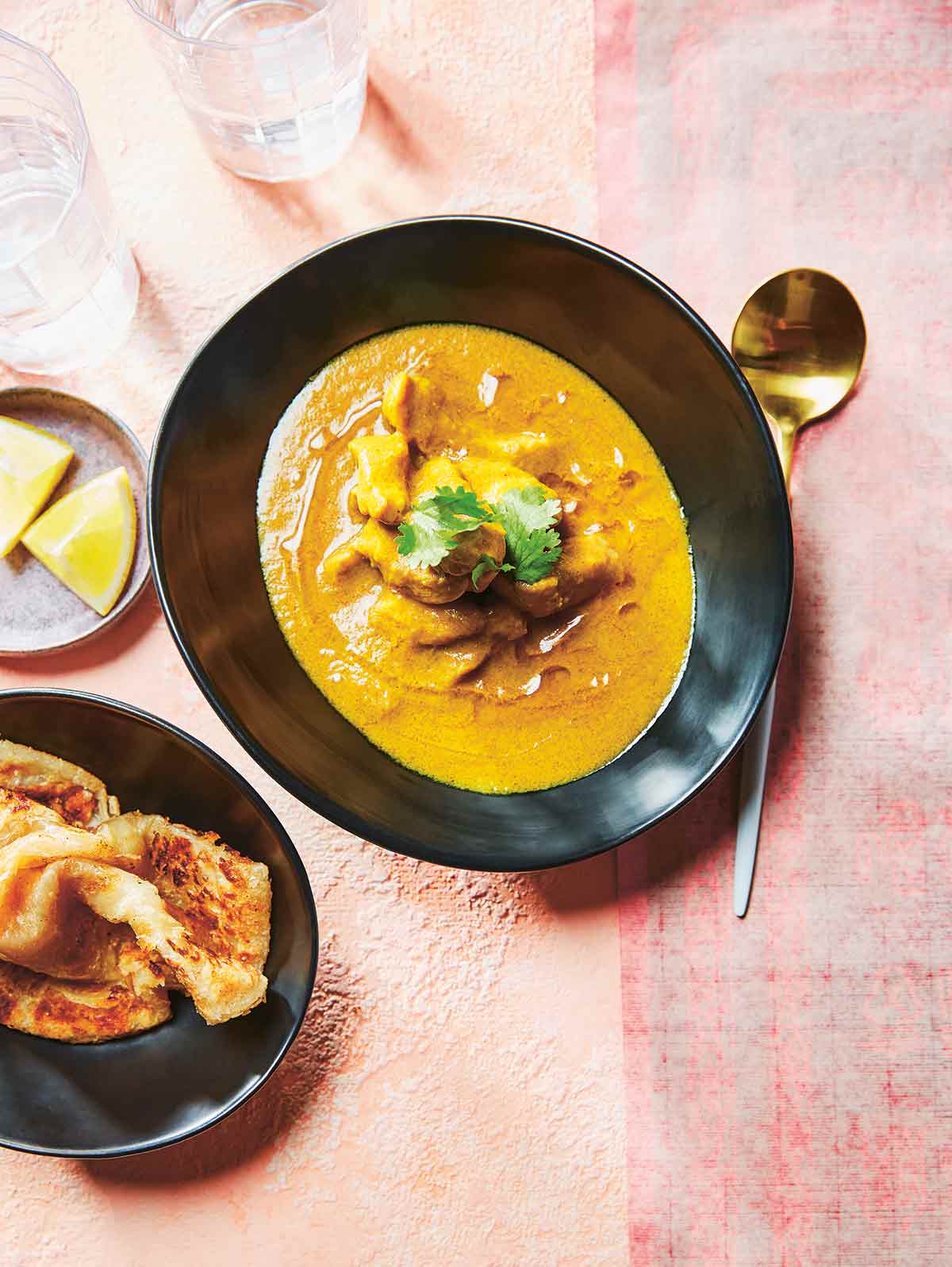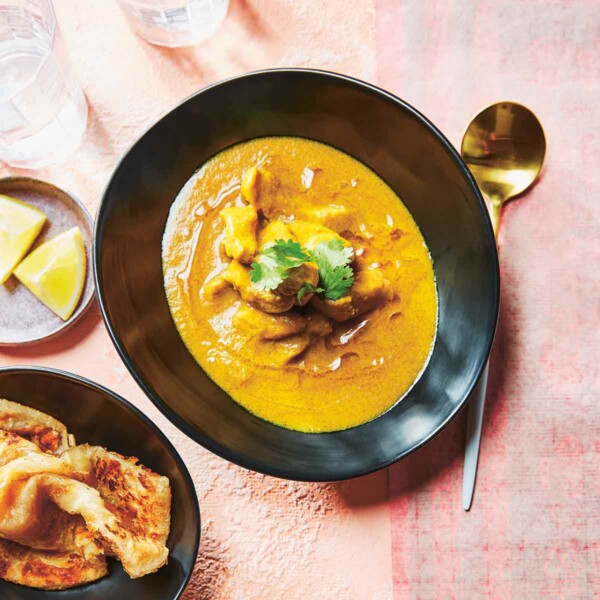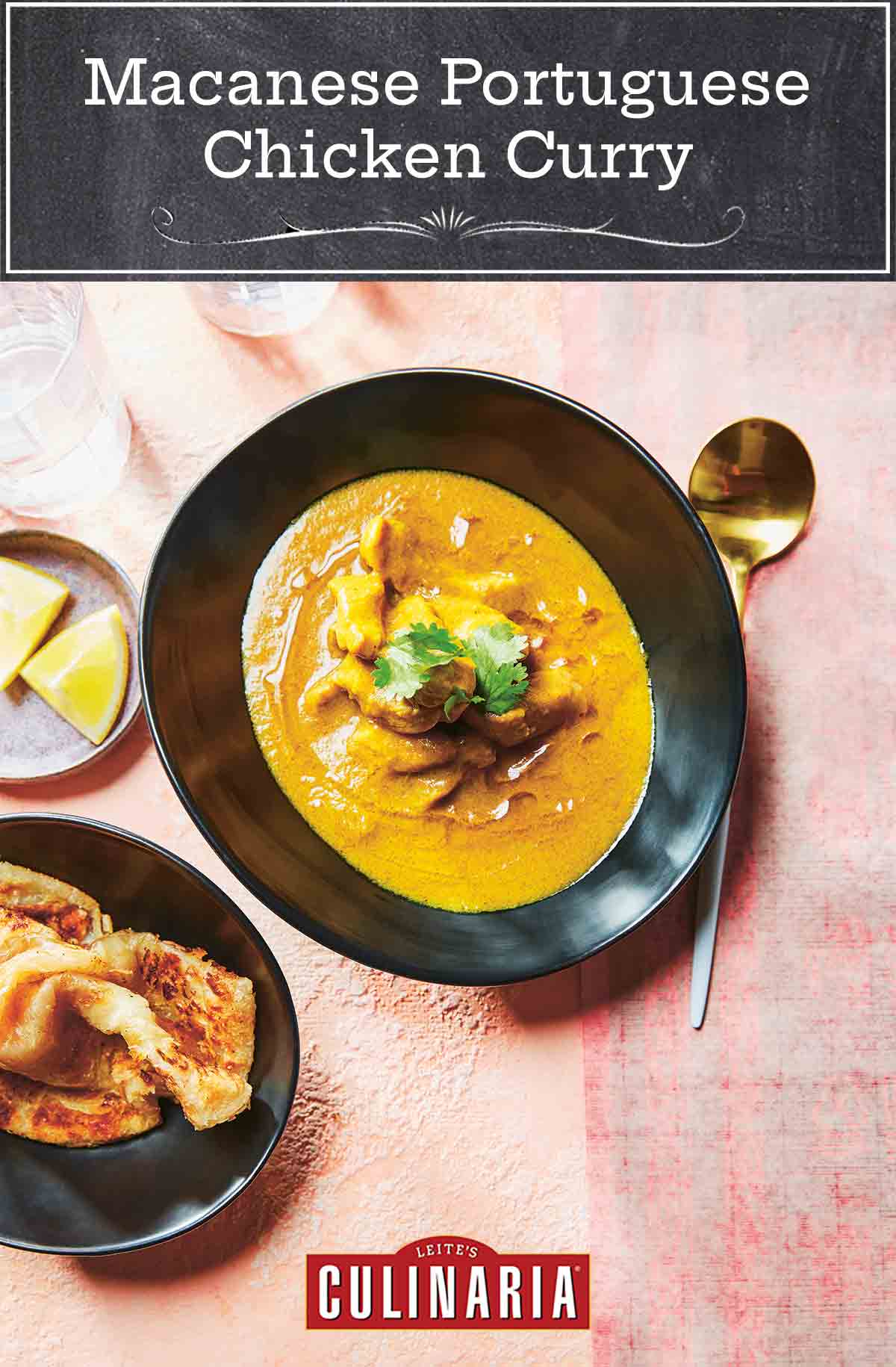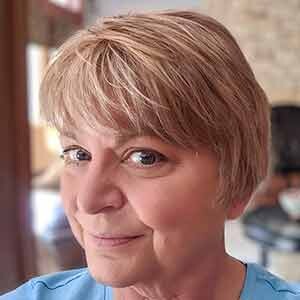
As immigrant kids, we had different things in our pantries. And when you’re left at home alone, you start to play around with some of these ingredients inside traditional dishes that you may not have if you’re not from an immigrant household. And I think a lot of that sings in what we see in restaurants today. A lot of influences and inspirations in certain dishes chefs cook are based on this fused culture of being a child of immigrant background melded with the culture of being North American.—Trevor Lui
Chicken Curry FAQs
If you’re serving curry to spice lovers, you can create more intense heat by adding powdered chile peppers or fresh peppers to your sauce during the cooking process. Kashmiri peppers are the traditional choice. If you’re serving a mixed crowd and need to add heat at the table, put additional chile oil, fresh sliced peppers, and a shaker of cayenne within reach.
On its own, coconut milk can separate if frozen and be slightly grainy when thawed but it’s still perfectly fine to eat. When used in a curry, the other ingredients may prevent the separation and stabilize the milk, but the thawed curry may be different texturally than pre-frozen and you may still encounter a bit of separation and granularity. Again, it’s still safe to eat.
Chicken thighs are often used because of their flavor and relative inexpensiveness. If you only have chicken breasts on hand, or if you just prefer them, then you can go ahead and substitute them. Honestly, you can use any combination of chicken pieces that your little heart desires. Just be aware that white meat cooks faster than dark so make sure that both are cooked if you mix them.

Macanese Portuguese-Inspired Chicken Curry
Ingredients
- 1 pound boneless skinless chicken thighs*, trimmed of excess fat and cut into bite-size pieces
- 1 tablespoon sweet paprika
- 1 teaspoon table salt, plus more as needed
- 1/2 teaspoon ground turmeric
- 1/3 cup canola oil
- 3 cups (18 ounces) finely chopped onions
- 5 cloves garlic, finely chopped
- One (13 1/2-ounce) can coconut milk
- 1 1/2 tablespoons fish sauce, plus extra to taste
- 1 1/2 cups water
- 1 teaspoon curry powder (such as Madras)
- 1/2 teaspoon cayenne pepper
- 1 tablespoon chile oil, for garnish
- 1/2 cup (2 oz) chopped fresh cilantro, for garnish
- Steamed rice or buttery naan, to serve
- 1 lime or lemon, cut into wedges, for garnish
Instructions
- In a medium bowl, combine chicken, paprika, salt, and turmeric and mix with your hands. Let the chicken marinate while you prepare the other ingredients (or refrigerate for up to 8 hours).
- In a large saucepan over medium-high heat, warm the oil. Add onions, reduce heat to medium-low, and sauté until translucent, about 10 minutes. Add garlic and cook until onions are cooked through and everything is coated in a glossy layer of oil, about 5 minutes more.
- Stir in the chicken and sauté for 4 to 5 minutes.
- Pour in coconut milk, increase heat to medium-high, and bring to a near boil. Simmer mixture until slightly thickened, about 5 minutes.
- Pour in fish sauce and water and bring to a boil. (The broth will thin as the chicken starts to release its juices.)
- Reduce heat to medium-low and simmer uncovered, stirring occasionally, until the curry has thickened and the flavor has developed, about 50 minutes. (Droplets of paprika-red oil will rise to the surface; this is okay).
- Stir in curry powder and cayenne and simmer for 15 minutes more. Remove from heat and let stand for at least 20 minutes for the dish to develop more flavor as it cools.
- Season with more salt or fish sauce, if needed. Drizzle chile oil over the top and sprinkle with cilantro. Serve with rice (or naan) and wedges of lime (or lemon).

Explore More with AI
Nutrition
Nutrition information is automatically calculated, so should only be used as an approximation.
Recipe Testers’ Reviews
This rich, creamy Macanese Portuguese chicken curry came together with ingredients I already had on hand–in my kitchen, it qualifies as a pantry recipe. The onions all but melt into the sauce, and since it’s so rich and doesn’t have any vegetables, it really should be one of several dishes making up a meal. I served it with leftover sesame eggplant and steamed rice. The mild eggplant was a good counterpart to the curry. The sauce is quite thick and you’ll want to check on it every few minutes in the final simmer so that it doesn’t stick.
I haven’t tried any dishes from Macau before except for egg tarts so this was an interesting journey into savory flavors. The recipe for Macanese Portuguese chicken curry is very straightforward and easy to understand. I used sweet Hungarian paprika, Red Boat fish sauce (my favorite!), light coconut milk, and hungyou chile oil which I make ahead now and keep in the refrigerator. I minced the 3 onions by pulsing in my food processor with the steel blade then tossed the garlic into the processor for the final few pulses.
Want to Save This?
The recipe makes a generous amount of curry sauce—perfect for serving over a big bowl of steamed rice or soaking up with naan. We enjoyed the freshness of the cilantro garnish and a big squeeze of lime along with a small drizzle of chile oil. The amount of heat from spices and oil was perfect for our tastes. My tweak would be using 4 chicken thighs. There was plenty of sauce compared to the amount of chicken since the size of chicken thighs range wildly from small to large and sometimes in the same package. I’m sure this dish is even better the next day!
This Macanese Portuguese chicken curry is an absolute FLAVOR BOMB. This doesn’t surprise me considering what went into the curry, especially the combination of cayenne and curry powders and that punchy fish sauce. The heat and earthiness don’t need elevating, but the smoky paprika I used gave it an extra complexity that’s hard to resist.
I think the only issue I had with this recipe is that I wish it made more than two servings, considering the amount of time it took to cook it. I’m also curious to see how the final product turns out if I do a longer marinade—guess I just have to make this again!
I liked this Macanese Portuguese chicken curry—it wasn’t too spicy but it had a really well-balanced flavor and tasted fresh. I used sweet paprika after reading that smoked wasn’t suggested and not wanting to use spicy. I also let it marinate overnight and found that the chicken had absorbed a lot of the flavors, making it incredibly good. This made 3 servings, which I served with rice. I found that I enjoyed it much more the next day.














This is one of those keep-in-your-back-pocket recipes, great for a chilly night and for when you have friends coming over. I omitted the water and dumped in a can of diced tomatoes (I can’t resist tweaking when I’m not testing!) and served over basmati rice, with a final drizzle of fish sauce during the final simmer. Fantastic, and I have something good to take to work!
That sounds like a wonderful meal, Lisa. Thank you so much for taking the time to comment.
Ah… yikes. From a Macanese person, this recipe is really bad. Like barely captures even a fraction of the original dish-bad. It looks like it’s written by someone who’s never stood foot in Macau and probably doesn’t understand the essence of Macanese cooking.
Lime, naan, fish sauce and cilantro have no business being in this dish. This resembles an awkward version of a khao soi more than anything else.
S P, thank you for weighing in. The recipe was written by a Chinese-Canadian chef whose family has been in the restaurant business for several generations–there’s no cultural appropriation here.
The chef writes about his recipes: “As immigrant kids, we have different things in our pantries. And when you’re left at home alone, you start to play around with some of these (ingredients) inside traditional dishes that you may not have if you’re not from an immigrant household. And I think a lot of that sings in what we see in restaurants today. A lot of influences and inspirations in certain dishes chefs cook is based on this fused culture of being a child of immigrant background melded with the culture of being North American.”
I’m Portuguese-American, and the dishes and variations of the dishes I grew eating are different from the ones back in Portugal. But they use the ingredients available locally and are adapted to the circumstances.
I think we all need to respect and be thoughtful of how ethnic dishes change and develop due to the diaspora of emigrants and their foods. Perhaps thinking of this as Macanese-inspired might help.
David, I’m aware that Trevor is Chinese. It is clearly stated in the text. Therefore, you’re right, there is no cultural appropriation and I never believed there was either. I also don’t doubt Trevor or his family as restauranteurs and/or chefs. In fact, I’m sure they are probably very talented at what they do due to their experience!
However, did he construct a good Macanese recipe? I unfortunately do not believe so.
Imagine this: someone publicly shares a carbonara recipe that incorporated chicken souvlaki and smoked gruyere. You could already guess the similar types of feedback it would receive. But you’re right, “inspired” is a very great way to put it! Too bad that’s not written anywhere on the site…
S P, thank you for your thoughtful reply. We’ve gone ahead and changed the title of the recipe to include the word “Inspired.” We hope that this honors both the chef as well as Macanese/Portuguese cooking.
Again, thanks for the great input.
This was a hit and will incorporate it in to our weeknight meals. I was drawn to it as the recipe had ingredients that most people have on hand …chicken, onions, coconut milk and a few staple spices. Although it takes some time, a lot of it is just “simmering” or “sitting” time so you can start it after work and not be tied to the stove the whole time. The only thing I slightly altered was that I used chicken stock rather than water in the recipe because I had an open container in the fridge. I made a pot of basmati rice with it and sprinkled fresh cilantro from my garden on top. 5 out of 5 !
That looks fantastic, Lene! Thanks so much for taking the time to let us know how much you enjoyed it.
I, myself, decided to forgo the water all-up. That decision made it a thick curry, which is much to my liking. Although it required a little more stirring here and there, but nothing too drastic. The additional tweaks that I made were adding some spinach near the end for freshness (need to get those vegetables in, may as well make them palatable), and throwing in some fenugreek and ground corriander with the other spices.
That made a flavour base that was distinct, and the right kind of spicy – not needing to have a gallon of milk on hand. It was also my second forray into cooking Macanese cuisine, which is a different breed entirely to most other Chinese cuisine. Plus, another winner for the record books.
It was easy to make, the kind that simply needs TLC while you make it. Perfect for the winter weather in the southern hemisphere. Plus, all the ingredients were on hand (minus the spinach, but that was my own addition). That means more likelihood of this meal coming from kitchen at a future moment.
Thanks, Mikey! I’m delighted that this was a winner for you. Thanks for taking the time to share your tweaks and experience.